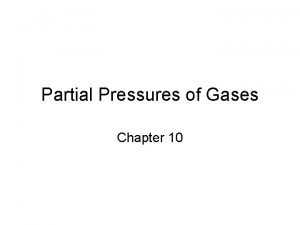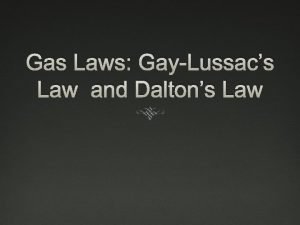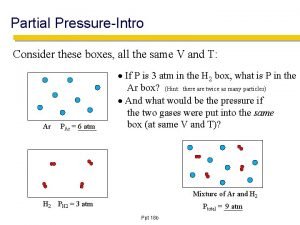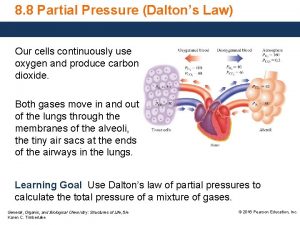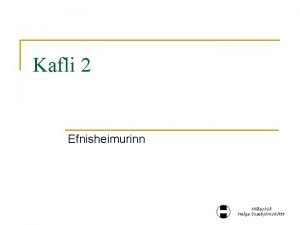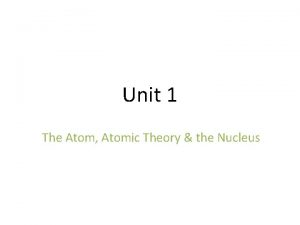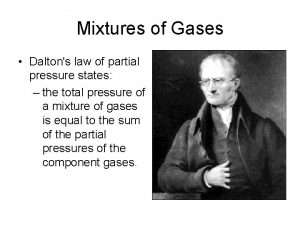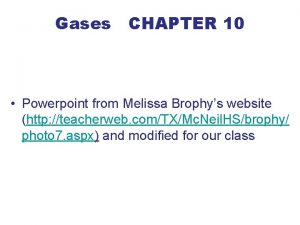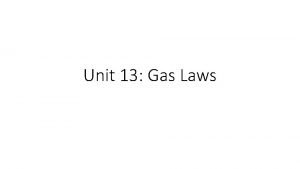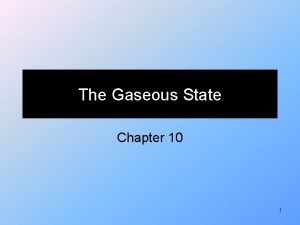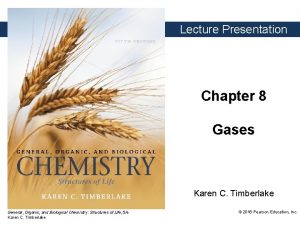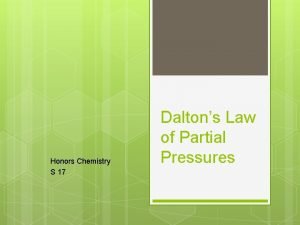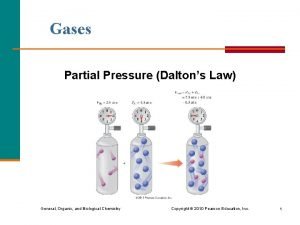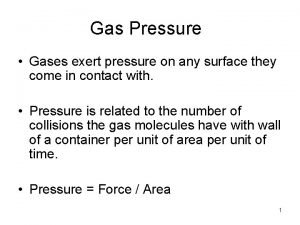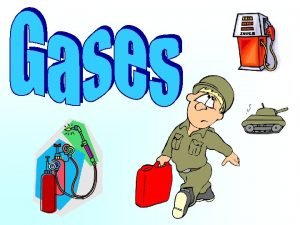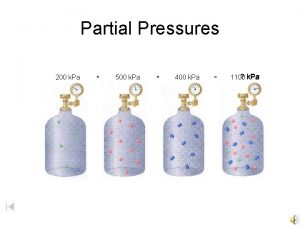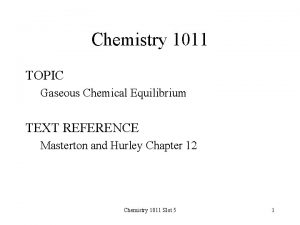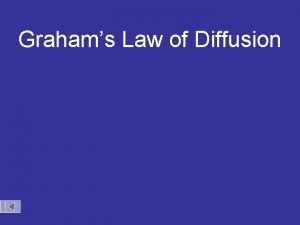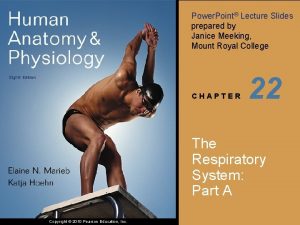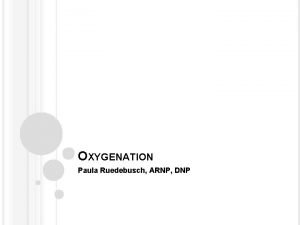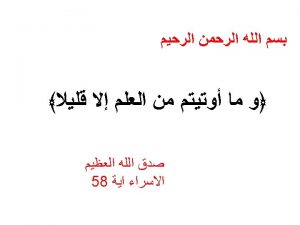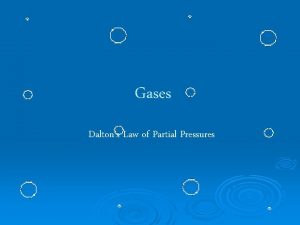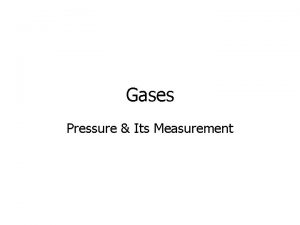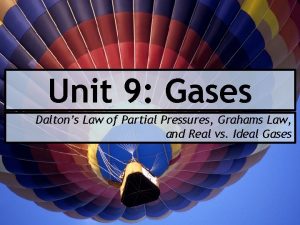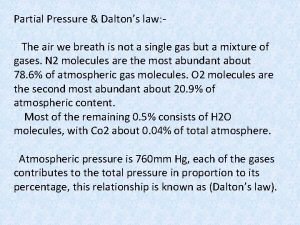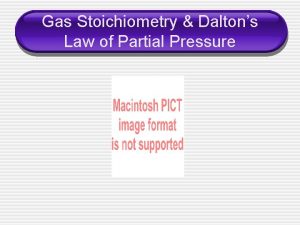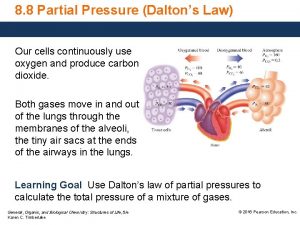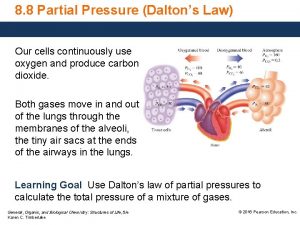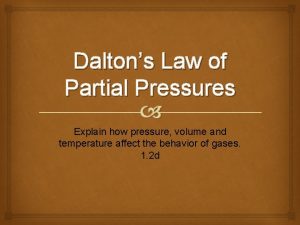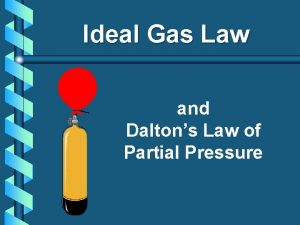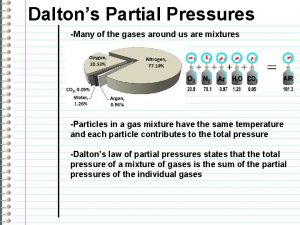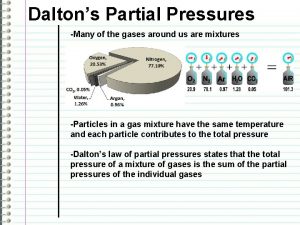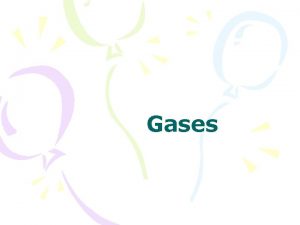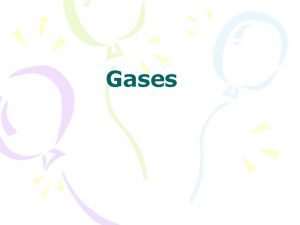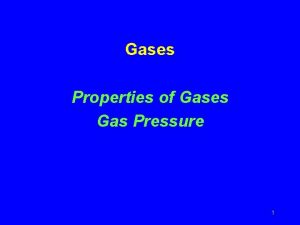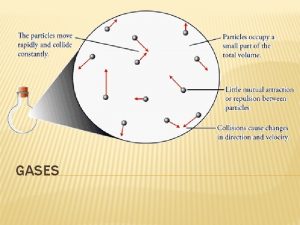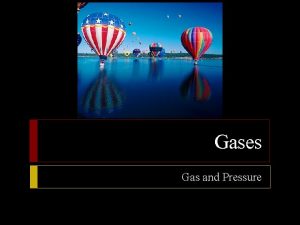Gases Daltons Law of Partial Pressure Named in




































- Slides: 36

Gases

Dalton’s Law of Partial Pressure � Named in honor of English scientist John Dalton. � He stated that gases mix homogeneously. � He also said that each gas in a mixture behaves as if it were the only gas present. � Dalton’ Law: For a mixture of gases in a container, the total pressure exerted is the sum of the pressures that each gas would exert if it were alone. � P total = P 1 + P 2 + P 3 +. . .

� The fact that the pressure exerted by an ideal gas is not affected by the identity (composition) of the gas particle reveal two things. � The volume of the individual gas particles must not be important. � The forces among the particles must not be important.

Dalton’s Law I � Mixtures of helium and oxygen are used in scuba diving tanks to help prevent “the bends. ” For a particular dive, 46 L He at 25 o C and 1. 0 atm and 12 L O 2 at 25 o C and 1. 0 atm were pumped into tank with a volume of 5. 0 L. Calculate the partial pressure of each gas and the total pressure in the tank at 25 o C.

Mole Fraction � A mole fraction (c) is the ratio of the number of moles of a given component in the total number of moles in the mixture. � The mole fraction equation: �c = � n 1 ntotal = P 1 Ptotal

Dalton’s Law � The partial pressure of oxygen was observed to be 1. 56 torr in air with a total atmospheric pressure of 743 torr. Calculate the mole fraction of O 2 present. � The mole fraction of nitrogen in the air is 0. 7808. Calculate the partial pressure of N 2 in air when the atmospheric pressure is 760. torr.

Gas Collection over Water � A sample of solid potassium chlorate (KCl. O 3) was heated in a test tube and decomposed by the following reaction: � � 2 KCl. O 3(s) 2 KCl(s) + 3 O 2(g) �The oxygen produced was collected by water displacement at 22 o C at a total pressure of 754 torr. The volume of the gas collected was 0. 650 L, and the vapor pressure of water at 22 o C is 21 torr. Calculate the partial pressure of O 2 in the gas collected and the mass of KCl. O 3 in the sample that was decomposed.

gas collection over water

Kinetic Molecular Theory � The kinetic molecular theory (KMT) is a simple model that attempts to explain the properties of an ideal gas. � gases consist of hard, spherical particles, atoms or molecules. � Because the particles are so small and the distances between them are so great, their individual volumes are insignificant. � The volume of a gas is mostly empty space. �. Property: Gases are highly compressible. �There are no attractive or repulsive forces between gas particles. � Gases are free to move inside their containers. �Property: A gas expands until it takes the volume and shape of its container.

Kinetic Molecular Theory � Gas particles move rapidly in constant random motion. � The particles travel in straight paths and move independently of each other. � Only when a particle collides with a container wall or another gas particle does it deviate from its straightline path. � In addition, collisions between gas particle are elastic, meaning that the total kinetic energy remains constant and that the kinetic energy is transferred without loss from one particle to another. � the average kinetic energy of a collection of gas particles is directly proportional to the Kelvin temperature of the gas.

Assumptions of KMT � The particles are so small compared with the distance between them that the volume of the individual particles can be assumed to be negligible (zero). � The particles are in constant random motion. The collisions of the particles with the wall of the container are the cause of the pressure exerted by the gas. � The particles are assumed to exert no forces on each other; the are assumed to neither attract nor to repel each other. � The average kinetic energy of a collection of gas particles is assumed to be directly proportional to the Kelvin temperature of the gas.

Justification of the gas laws using KMT � Pressure and Volume (Boyle’s Law). � Law: For a given sample of gas at constant T and n, if the volume of a gas is decreased, the pressure increases. � V = (n. RT) 1/P � � KMT: Since a decrease in volume means that the gas particles will hit the container wall more often, the pressure should increase.

Volume and Temperature (Charles’s Law). � Law: At constant P and n, the volume of a gas is directly proportional to the Kelvin temperature. � � V = (n. R/P) T � KMT: When a gas is heated to a higher temperature, the speeds of its molecules increase and thus hit the walls more often with more force. The only way to keep the pressure constant in this situation is to increase the volume of the container.

Volume and Number of Moles (Avogadro’s Law) � Law: The volume of a gas at constant P and T depends directly on the number of gas particles present. � V = (RT/P) n � KMT: An increase in the number of gas particles at the same temperature would cause the pressure to increase if the volume were held constant. The only way to return the pressure to its original value is to increase the volume. � It is important to recognize that the volume of a gas depends only on the number of gas particle present. � The individual volumes of the particles are not a factor because the particle volumes are so small compared to the distances between the particles.

Mixture of Gases (Dalton’s Law). �Law: The total pressure exerted by a mixture of gases is the sum of the pressures of the individual gases. � �KMT: All gases are independent of one another and the volumes of the individual particles are unimportant. Thus the identities of the gas particles do not matter.

Diffusion �~Movement of a gas from an area of high concentration to an area of low concentration. �This is why you can smell perfume all throughout a room when it is sprayed. �Using the ideal gas model- you wouldn’t expect a certain type of atoms to stay together.

High Diffusion Low All particles move randomly. There is no desire to travel anywhere. However, there are more particles at high pressure than low pressure. So the probability of particles going from high to low is higher than from low to high.

Diffusion �On the last slide say there were 5 particles at low pressure and 100 at high pressure. �Each particle has a 1/5 chance of moving from 1 circle to the other. What happens? � 1 moves from low to high � 20 move from high to low �That means we have a net flow of 19 particles from high to low. �To make it a reasonable amount we really need much more than 100 particles to start so put a x 1023 at the end of all numbers.

Effusion �~a gas moving through an opening. �Like a tire with a leak in it. �Really this only depends on the likelihood of a particle reaching the “hole”. �Which is dependant upon the number of particles present and the speed of the particles.

Tire with a leak The particle inside have a higher pressure than the particles outside. Tire The material will be weak on either side and open like flaps That means there is more gas particles on the inside than on the outside Therefore they should hit the hole and escape more often than outside particles.

Tire with a leak Any individual particle inside or outside of the tire should have the same chance of hitting the “hole”. The particles inside have a higher pressure than the particles outside. Which means there are more particles in a given area inside the tire than outside. Tire The material will be weak on either side and open like flaps Therefore more inside particles should hit the hole than outside particles, and there should be net flow of air particles outward.

Comparing the rates of effusion of gas molecules �All gases will not effuse at the same rate. �It depends on the speed of each gas molecule. �At the same temperature, all particles will have the same kinetic energy, but they all have different masses (their molar mass). �KE = ½ mv 2 �Therefore, their velocities must be different. �The faster moving particles will cover more ground in the same amount of time and be more likely to find the opening.

Effusion � Thomas Graham (1805 -1869), found experimentally that the rate of effusion of a gas is inversely proportional to the square root of the mass of its particles. � Graham’s Law of Effusion: � � Effusion Rates. � Calculate the ratio of the effusion rates of hydrogen gas (H 2) and uranium hexafluoride (UF 6), a gas used in the enrichment process to produce fuel for nuclear reactors.

Temperature � Temperature is a measure of the energy of molecular motion; a transfer of KE from collisions of higher energy objects to collections of lower energy particles. � Equation: � � The root mean square velocity (urms) is the square root of the average of the squares of the individual velocities of gas particles. �M = molar mass in kg /mol

Root Mean Square Velocity �An important factor to remember is that not all gas molecules will go the same speed. There will be a mean velocity, and other particles will go faster or slower. The can be set up in a probability distribution curve. �Calculations of root mean square velocity are off of the test

Maxwell Botzmann distribution �This describes particles speeds in ideal gases that particles at a certain temperature can move without intermolecular forces acting on them. �The graph is a probability distribution for the speeds of the particles. �This graph �Is for 25 o C

Maxwell distribution for oxygen at different temperatures �We still see a similar pattern. The peaks are higher, which mean more particles at the mean when the particles are slower moving. Faster moving gives you a greater standard deviation.

Real Gases � No real gas follows exactly what the KMT predicts. This is because… � Atoms/molecules do have finite molecular volumes. � Attractions do exist between molecules. � When temperature decreases or pressure increase, condensation occurs. � Real gases behave nearly ideally, act like KMT predicts, under ordinary conditions of low pressure and high temperature.

Plots of PV/n. RT Versus P for Several Gases (200 K) 29 Copyright © Cengage Learning. All rights reserved

Plots of PV/n. RT Versus P for Nitrogen Gas at Three Temperatures 30 Copyright © Cengage Learning. All rights reserved

The van der Waals Equation � This equation adjusts pressure “up” and volume “down. ” � � corrected pressure corrected volume Pideal Videal � The a and b variables are the van der Waals constants. � They are positive values specific to each gas. � They are obtained from a table. �a is related to molar mass and relate with the strength of the intermolecular attractions. � b is a measure of actual molecular volume.

Values of the van der Waals Constants for Some Gases The value of a reflects how much of a correction must be made to adjust the observed pressure up to the expected ideal pressure. � A low value for a reflects weak intermolecular forces among the gas molecules. � 32 Copyright © Cengage Learning. All rights reserved

Inter/Intramolecular Attractions. � Intramolecular forces These are forces within a molecule or polyatomic ion. � They are also referred to as bonding forces. �These influence chemical properties. � Intermolecular Attractions (IMA). � These are forces between molecules, ions, or atoms. � They influence physical properties.

States of Matter � For a gas, the energy of attraction (IMA) is less than the energy of motion. The particles, therefore, are far apart. � For a liquid, the energy of attraction (IMA) is stronger, but KE allows for movement. The particles, therefore, are closer, but with motion. �For a solid, the energy of attraction (IMA) is greater than the energy of motion. The particles, therefore, as arranged in a fixed, organized pattern.

Types of Intermolecular Attractions. � Ionic attractions- very strong. All ions are attracted to all opposite ions � Metallic attractions- very strong. Sea of electrons keep all nuclei tightly bound � Dipole/dipole attractions- weak. The larger the difference in electronegativity, the stronger the attractions. Larger molecules are more polarizable. � Hydrogen bonding- strongest dipole-dipole (still weak). Occurs within an element that has Nitrogen, Oxygen, or Fluorine (NOF) bonded to Hydrogen. � London dispersion- weakest.

London Forces �This force is random and short lived, as the electrons do constantly move, and will eventually end the dipole moment. �It is also fairly weak. �You can tell it is really weak in helium because it stays a gas until -268. 9 o C. �Larger atoms or molecules (with more electrons) have stronger London forces. �With more electrons it is easier for the atom or molecule to have its electrons unbalanced and stay that way for an extended period of time. �Iodine (I 2) is a solid at room temperature.
 Daltons gas law
Daltons gas law Dalton's gas law
Dalton's gas law Partial pressure formula
Partial pressure formula How to find partial pressure from total pressure
How to find partial pressure from total pressure Sameindamassi
Sameindamassi Dalton atomic theory summary
Dalton atomic theory summary Daltons experiment
Daltons experiment Partial pressure
Partial pressure Unit of universal gas constant
Unit of universal gas constant Boyle's law example
Boyle's law example Charles law
Charles law Karen 2
Karen 2 Dalton's law states that
Dalton's law states that Dalton's law of partial pressure
Dalton's law of partial pressure Partial pressures of gases pogil answers
Partial pressures of gases pogil answers How does a gas exert pressure
How does a gas exert pressure Do gases exert pressure on whatever surrounds them
Do gases exert pressure on whatever surrounds them Gibbs free energy with partial pressure
Gibbs free energy with partial pressure The partial pressure of oxygen was observed to be 156 torr
The partial pressure of oxygen was observed to be 156 torr How to find partial pressure at equilibrium
How to find partial pressure at equilibrium Partial pressure of a gas
Partial pressure of a gas Immiscible
Immiscible Newton's first law and second law and third law
Newton's first law and second law and third law Newton's first law and second law and third law
Newton's first law and second law and third law Boyles law
Boyles law P=k/v
P=k/v Rate of diffusion formula
Rate of diffusion formula Patella baja
Patella baja Pressure support vs pressure control
Pressure support vs pressure control Continuous bedside pressure mapping
Continuous bedside pressure mapping Intrapulmonary pressure
Intrapulmonary pressure Starling forces
Starling forces Tripod position breathing
Tripod position breathing Metamorphic grade
Metamorphic grade Sore throat after surgery
Sore throat after surgery Bernoulli equation mass flow rate
Bernoulli equation mass flow rate Afferent and efferent arterioles
Afferent and efferent arterioles
